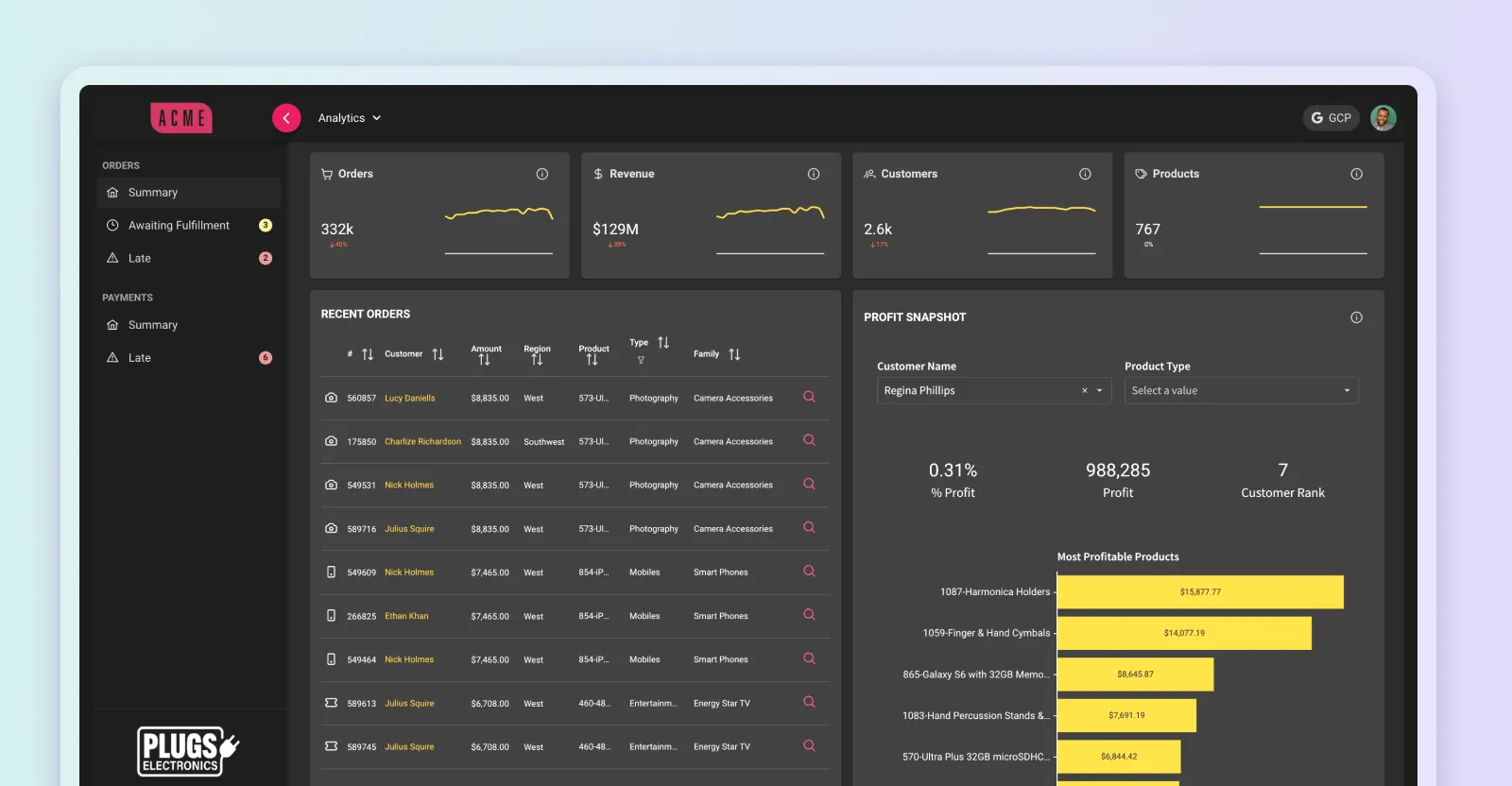Sigma Embed Analytics to Simplify Supply Chain Management
Table of Contents

The Value of Data-Driven Insights for Manufacturing
Businesses that have instant access to data are able to make faster, better decisions and stand out from the competition. The world’s most profitable manufacturers utilize analytics to make judgments based on factual data from past performance and current trends to maximize profits and boost productivity. Although demand for data-driven insights is at an all-time high, most organizations are hindered by traditional analytics solutions that only work for the most technical users and/or data teams.
Sigma enables all users with insights into key performance indicators (KPIs) that matter, such as production throughput, equipment downtime, and quality measurements - all from within a familiar spreadsheet-like user interface. To further streamline processes, Sigma’s embedded analytics are integrated directly into existing applications and process workflows, giving users access to real-time data and insights. Because Sigma uses the power of your cloud data warehouse, speed and scale are no longer limitations. Gone are the days of batch processing and stale, outdated data.
For example, Sigma helps Fictiv strengthen its digital manufacturing ecosystem with real-time insights. As a data-driven organization, Fictiv relies on product and system data to surface customer insights and gain greater visibility into its vast network of manufacturing partners. These insights help steer product improvements and business strategy, improve system design, and increase workflow efficiency.
As a cloud-first company, Fictiv’s centralized Snowflake data warehouse stores information from dozens of sources and systems that its business teams rely on each day. This includes an ERP, a CRM, and their own product. Despite this central source of data truth, Fictiv has a relatively small data team that wasn’t able to keep up with the demand for dashboards, reports, and ad hoc analysis using its previous data analytics platform.

With Sigma, Fictiv benefits from deeper transparency and integration across their diverse network of systems. From product usage metrics to vendor performance, material characteristics to industry trends — data from a diverse and wide range of sources is able to be analyzed holistically by the Fictiv team to fuel critical business analysis, develop key success metrics, and shape overall strategy.
Examples of how Sigma’s customers utilize embedded analytics in Manufacturing
Estimate Market Demand
All too often, Demand Planners find themselves manipulating data in Excel. Sigma provides a familiar spreadsheet interface, but with robust drill-down capabilities for unencumbered ad-hoc analysis, live data for real-time updates, and the ability to input critical context back into the data itself. In a forecasting scenario, Sigma enables rapid detection of recurring patterns and abnormalities in data via conditional alerts through emails, slack, or webhooks into the system of your choice. Because of this, it’s easier to decide what needs to be prioritized and where the attention should be directed. Perhaps most importantly, all of this can be integrated into existing software applications and workflows that might otherwise require bouncing between multiple screens.
Real-time Monitoring of Industrial Operations
The ability to track industrial operations in real time is one of the main advantages of Sigma. Operators can detect possible bottlenecks, equipment failures, or quality problems early on and take action before they have an impact on production. Sigma can handle billions of rows of data without speed or scale limitations, so data from sensors, machines, and other sources can be utilized. This can greatly lower downtime and Improve general equipment efficiency (OEE).
Reducing Waste while Boosting Quality
Moreover, Sigma can aid producers in enhancing quality and decreasing waste. Operators can find the origins of errors or inefficiencies and take action by gathering and evaluating data from production operations, then collaborate and add notes in real time. More than a reporting and analysis tool, Sigma brings people and operations together to refine processes based on data.
Enhance Supply Chain Transparency and Cooperation
With Sigma embedded analytics, manufacturers can obtain a comprehensive understanding of their whole supply chain by integrating data from suppliers, logistics providers, and other partners. This data and analysis can be shared securely between manufacturers and suppliers via an interactive and collaborative supplier portal. This can assist manufacturers in lowering lead times, increasing delivery performance, and optimizing inventory levels.

In this example, Plugs Electronics is the manufacturer and Acme is the supplier. Acme can see how they are measured and have full visibility into late and outstanding orders, all from within a secure, interactive portal.
Make better decisions, faster
Real-time insights into the production process are one of the Sigma major advantages. Manufacturers can get the most up-to-date information on production, inventory levels, and quality measures by integrating analytical tools into business software. Operators can therefore make more timely decisions and change their strategy as necessary.
Sigma focuses heavily on self-service, enabling non-technical users to ask and answer their own questions without having to wait for a member of the data team to produce yet another report or create a dashboard.
Real Time Analysis with Input Tables
Sigma’s Input Tables reframe how data analytics and business teams integrate human context with real production data to achieve their goals more quickly and at a much larger scale. Sigma provides an altogether new paradigm for dealing with your warehoused data. In order to create a more detailed analysis, it allows users to manually enter data at the cell level, in addition to their already-stored data. These tables are produced, gathered, modified, and managed using the Sigma interface and are stored in your cloud data warehouse. Sigma's input tables can assist manufacturers in receiving information from stakeholders so they can do real-time analysis.
Conclusion
The best manufacturers in the world recognize the benefits of using data to make better business decisions, yet most struggle to keep up with ad-hoc requests. Using traditional business intelligence tools, new questions can take days or weeks to answer and often require technical resources to produce yet another report or dashboard.
Sigma enables non-technical end users to ask and answer their own questions within a familiar, spreadsheet-like user interface that utilizes the speed and scalability of your cloud data warehouse. Sigma’s embedded analytics allows manufacturers to share that information with vendors, suppliers and customers to provide timely, data-driven insights on billions of rows of data.














